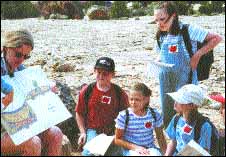|
May 13, 2000 By Jim Mimiaga
They arrived in orderly groves, notebooks and cameras in hand, to a slickrock-canyon trailhead known for its rich human history and natural wonders ó an ideal laboratory for discovering what life was like a millennium ago. And, as many of the 130 area fourth graders who explored Sand Canyon learned Thursday, the agricultural values that flourish today originated during the heyday of the Anasazi Pueblo culture, the first modern Americans. "Does anyone here live on farms that your ancestors homesteaded in this area?" asked Margie Connolly, of Crow Canyon Archeological Center in Cortez, to a group of students. Several hands of farm children adorned with adult-sized John Deere and seed-company caps tentatively went up, providing Connolly with a perfect segue to point out the link between the past and the present in a classroom setting juxtaposed by Castle Rock ruin in the foreground, and greening fields of alfalfa and pinto beans in the distance. "McElmo Canyon is a natural corridor between the mountains and the desert that people have been passing through for 1,000 years, settling in and farming," she said. "As your families do today, the people before them also managed the land for food, built reservoirs for irrigation and raised families." The second-annual Sand Canyon field trip is sponsored by Crow Canyon and funded in part by a $15,000 Berger Foundation grant. The four-day event brought a total of 400 fourth grader students from the Cortez, Mancos and Dolores school districts, including the Battle Rock Charter School, to the popular ruin-filled canyon, set to be the center piece of a proposed national monument expected to be announced soon for the region. Highlighting a series of lessons on the cultural significance of what has been called "The Canyons of the Ancients" by U.S. Rep. Scott McInnis, the tour rotated groups between sessions that focused on hunting and wildlife, geology, archeology, Ute history, botany and Ancestral Puebloan culture. Students kept journals on what they have learned, and colored in a realistic drawing created by Crow Canyon artist Paul Ermigiotti of what a typical scene was probably like during the Pueblo III period. The image shows low-profile residences, and ceremonial kivas with people and children wearing animal-hide clothing milling about with domesticated horses and dogs, and carrying tools. "The picture was drawn based on the way the ruins were excavated and represents what we think this area looked like back then without being too dramatic," said Elaine Davis, education director for Crow Canyon. "It gives the kids a picture in their mind so that they know that these places are not just ruins, but places where people lived." And danced, added Connolly, pointing to a nondescript flat area below Castle Rock ruin that was likely used as an ancient town plaza. The area is conspicuously circled by giant boulders, a mystery that may have been recently solved. Closer inspection by scientists revealed that moss and lichens on the bottom of the boulders date back 800 years, suggesting that they were moved by people to their current location as a type of fence around the plaza. "When Native Americans visit these places, they donít just look at the ruins, they also look for the plazas where the dances were held. It is a different perspective that we can learn from them, because we know that this is their history," Connolly told the kids. Parents also took time out to learn from the experience, many of whom could be seen tromping beside their children as they hiked from session to session. "This is the first time Iíve been here, even though I must have driven by it a million times, always busy doing something," said Susie Phillips, of Lewis. "I really like it, and my daughter has been learning a lot about Native American history." |
||
|
|
